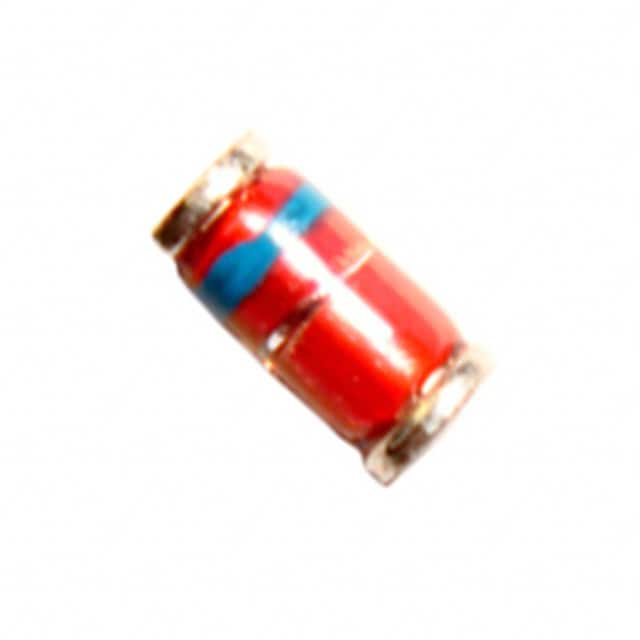DL4005 Product Overview
Introduction
The DL4005 is a diode belonging to the category of rectifier diodes. It is widely used in electronic circuits for its specific characteristics and applications. This entry provides an overview of the DL4005, including its basic information, specifications, pin configuration, functional features, advantages and disadvantages, working principles, application field plans, and alternative models.
Basic Information Overview
- Category: Rectifier Diode
- Use: The DL4005 is commonly used in electronic circuits to convert alternating current (AC) to direct current (DC).
- Characteristics: It has a low forward voltage drop and high surge current capability.
- Package: The diode is typically available in a DO-41 package.
- Essence: The DL4005 is essential for converting AC to DC in various electronic applications.
- Packaging/Quantity: It is often sold in reels or tubes containing multiple units.
Specifications
- Maximum Average Forward Current: 1A
- Peak Forward Surge Current: 30A
- Maximum Reverse Voltage: 600V
- Forward Voltage Drop: 1V at 1A
- Operating Temperature Range: -65°C to +175°C
Detailed Pin Configuration
The DL4005 has two pins: 1. Anode (A) 2. Cathode (K)
Functional Features
- Efficient conversion of AC to DC
- Low forward voltage drop
- High surge current capability
- Reliable performance in various electronic circuits
Advantages and Disadvantages
Advantages
- Low forward voltage drop reduces power loss
- High surge current capability ensures reliability in demanding conditions
- Compact package for easy integration into circuit designs
Disadvantages
- Limited maximum reverse voltage compared to some other diode models
- Sensitive to temperature variations in extreme operating conditions
Working Principles
The DL4005 operates based on the principle of unidirectional conduction, allowing current to flow in only one direction. When forward-biased, it efficiently conducts current, enabling the conversion of AC to DC. Its low forward voltage drop minimizes power dissipation during operation.
Detailed Application Field Plans
The DL4005 finds extensive use in the following applications: - Power supply units - Battery chargers - LED lighting systems - Motor drive circuits - Solar energy systems
Detailed and Complete Alternative Models
Some alternative models to the DL4005 include: - 1N4001 - 1N4002 - 1N4003 - 1N4004 - 1N4006 - 1N4007
In summary, the DL4005 rectifier diode offers efficient AC to DC conversion, with its low forward voltage drop and high surge current capability making it suitable for diverse electronic applications.
Word Count: 398
기술 솔루션에 DL4005 적용과 관련된 10가지 일반적인 질문과 답변을 나열하세요.
What is DL4005?
- DL4005 is a high-voltage rectifier diode commonly used in power supply and voltage regulation applications.
What are the key specifications of DL4005?
- The DL4005 has a maximum repetitive peak reverse voltage of 600V, an average forward current of 1A, and a forward voltage drop of around 1V at 1A.
How is DL4005 typically used in technical solutions?
- DL4005 is often used in rectification circuits, voltage regulators, and power supplies to convert alternating current (AC) to direct current (DC) and to regulate voltage levels.
What are the common alternatives to DL4005?
- Common alternatives to DL4005 include other high-voltage rectifier diodes such as 1N4007, 1N5408, and FR307.
What are the typical applications where DL4005 is not suitable?
- DL4005 may not be suitable for applications requiring higher current ratings or ultra-fast switching speeds.
What are the potential failure modes of DL4005 in technical solutions?
- Potential failure modes of DL4005 include overvoltage breakdown, excessive forward current leading to thermal runaway, and physical damage due to mechanical stress.
How can DL4005 be protected from overvoltage conditions?
- DL4005 can be protected from overvoltage by using transient voltage suppressor (TVS) diodes, varistors, or voltage clamping circuits in parallel with the diode.
What are the thermal considerations when using DL4005 in technical solutions?
- Thermal considerations for DL4005 include proper heat sinking to dissipate heat generated during operation and ensuring that the diode operates within its specified temperature limits.
Can DL4005 be used in reverse-biased mode?
- Yes, DL4005 can be used in reverse-biased mode to block the flow of current in the reverse direction, but care should be taken to stay within the specified reverse voltage limits.
Are there any specific layout or PCB design considerations for using DL4005?
- Proper PCB layout and design considerations include minimizing trace lengths, providing adequate clearance and isolation, and incorporating appropriate decoupling capacitors for noise suppression.
Please let me know if you need further information on any of these questions!


